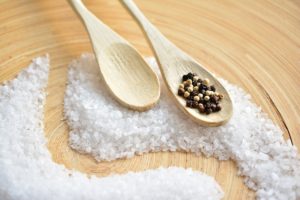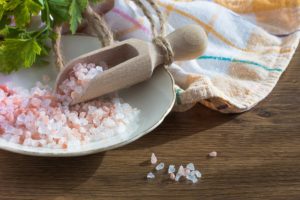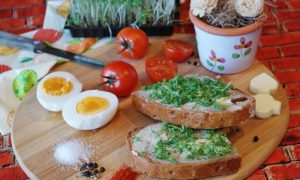If you’ve never used or heard of gourmet salt before, you’re not alone. That was me a couple of years ago. The only salt I knew was iodized salt (and seasoned salt) from the grocery store, and it did the job well. Now you see gourmet salt anywhere you go, in foodie or cooking shops and even in many grocery stores, as it is becoming more common.

Where does salt come from and is all salt the same?
Salt has been around for ages and one of the most important roles it played was for preserving food from going bad. Think salted meat, pickled vegetables, etc. Of course, salt adds flavor to our food too.
Ordinary table salt as we know it and gourmet salt both come from the same source: the sea. Sea brine is collected in ponds or large shallow pans where water is naturally evaporated by the sun, and in some cases with the help of fuel. Once the water has completely evaporated, only salt crystals or rocks remain, which is what we know as salt. In some areas like the Himalayas, salt is mined too. According to all articles I read, that’s where the similarities end between table and sea salt.

So what is gourmet salt?
Table salt is chemically processed to strip all impurities and minerals except sodium chloride. In sea salt, minerals from the sea or area of origin are still present, giving this salt some color. Colors range from pink, reddish, to grey or black and are colored by local clay, algae, lava or activated charcoal.
But color is not the only factor that makes this salt special; the texture of the crystals or flakes add another dimension, or we should say crunch to the food it is used on.
Gourmet salt could be any of the above, although some are mixed with herbs and spices to take the flavor a bit further.

Types of gourmet salt
Just like anything else, there is a variety in gourmet salt too, depending on where it was mined or processed. The main categories are crystals and flakes.
Flake salt is light and delicate, retains its shape and gives your food an appealing look, adding some crunch before it quickly melts. An example of flake salt is Cyprus and Kosher salt.
Crystal salts come in different varieties as well. From small crystals to larger rock crystals, such as Himalayan or French salts.
Besides shape and color, gourmet salts are also distinguished by flavor and property.
Smoked salts can have (artificial) smoke flavor added, or by naturally smoking in chambers using different types of wood for a special flavor. It goes without saying that the latter have the best flavors. Examples are Hickory or Mesquite salt.
Colored salts may come from various areas. Pink salts may come from the Himalayas, Australia or Peru; red or black salts are more common to Hawaii and India; most grey salts are from French regions. Pink salts are subtler and more often used as table salt, for soups, pasta and stews, while the red and black varieties are more bold and great for roasting or grilling.
Wet salts have more moisture than other salts that are considered dry salts. Why would a chef want to use wet salt, you think? For the surprising reason that wet salt doesn’t ‘steal’ moisture from the food it’s cooked with. Did you know? I didn’t, but it’s genius! Examples of wet salt are Sel Gris and Fleur de Sel, both coming from France and appropriate for distinct uses. Sel Gris is used to flavor heavier meats and vegetables, while Sel Gris is more delicate and better for salads and fish.
Gourmet salt on raw and cooked steaks
|
|
|
I remember my first experience with gourmet salt a couple of years ago. Someone gave us Brazilian salt and at the time I thought, what’s so different about this? We were supposed to sprinkle it on meat before grilling or roasting, the way it’s done in Brazil and Argentina for Churrasco style steaks. Salt is sprinkled on the meat right before roasting above flames. At that time, I couldn’t detect any difference in flavor and it bothered me that the salt looked “dirty.” It was probably Grey Sel, but what did I know? Nothing about gourmet salts that’s for sure, because after cooking with it several times I finally tossed it out. Oh my, I had just ditched a valuable gourmet salt! Lessons learned!
Now that I am a bit wiser, I’m trying out various types and I can’t imagine not having any in my kitchen to finalize some of my dishes.
How is gourmet salt used?
Not only does it have more texture than table salt, gourmet salt doesn’t melt as fast and in my opinion is not as “salty” either. To enjoy the texture, gourmet salt is to be added at the end of cooking or right before serving, otherwise you will lose the special characteristics like crunchiness and flavor.

Too many times I’ve eaten out and couldn’t finish my dish because it was too salty. I bet those chefs did not use sea salt or gourmet salt! Now that you know a bit more about gourmet salt, I hope that you too will experiment with various flavors and textures.
When I was doing research for this article, I found some delicious looking gourmet salts, packaged for sampling or as gift for that foodie friend in your life! These are available on Amazon.
Please note that if you buy from the Amazon links on this page, I may earn a commission. There is no additional cost to you, but it will help to maintain this site. Thanks for your support!
Gourmet Salts
 |
 |
 |
 |
A sea (world) of salt
As I’m learning more, I’m slowly discovering the “world of salt” because before my experiences, I had never heard of a salt cellar. No, it’s not a basement full of salt, but rather a container with/without a lid used to quickly get some salt for sprinkling, making it easier to control the quantity of salt.
The first time I saw a salt cellar was in my son’s kitchen. He’s a bit of a “gourmet” hobbyist and had an open marble container with grey salt on the counter next to the stove. I asked him why it didn’t have a lid and he replied that the dry, air-conditioned air helped to keep the salt dry. That made sense!
I prefer a covered dish and bought one of glass, allowing me to see the beautiful pink Himalayan salt in the container. There are so many varieties of salt cellars and bowls available, something for everyone’s taste. I found some cute ones on Amazon to share with you.
Salt Cellars
Do you use one? If so, where did you get yours?
Other “salty” gifts
 |
 |
 |
 |
Resources:
Sea Salt (Wikipedia)
A complete guide to flavored gourmet salts
Making the most of gourmet salts
How to use gourmet salt


